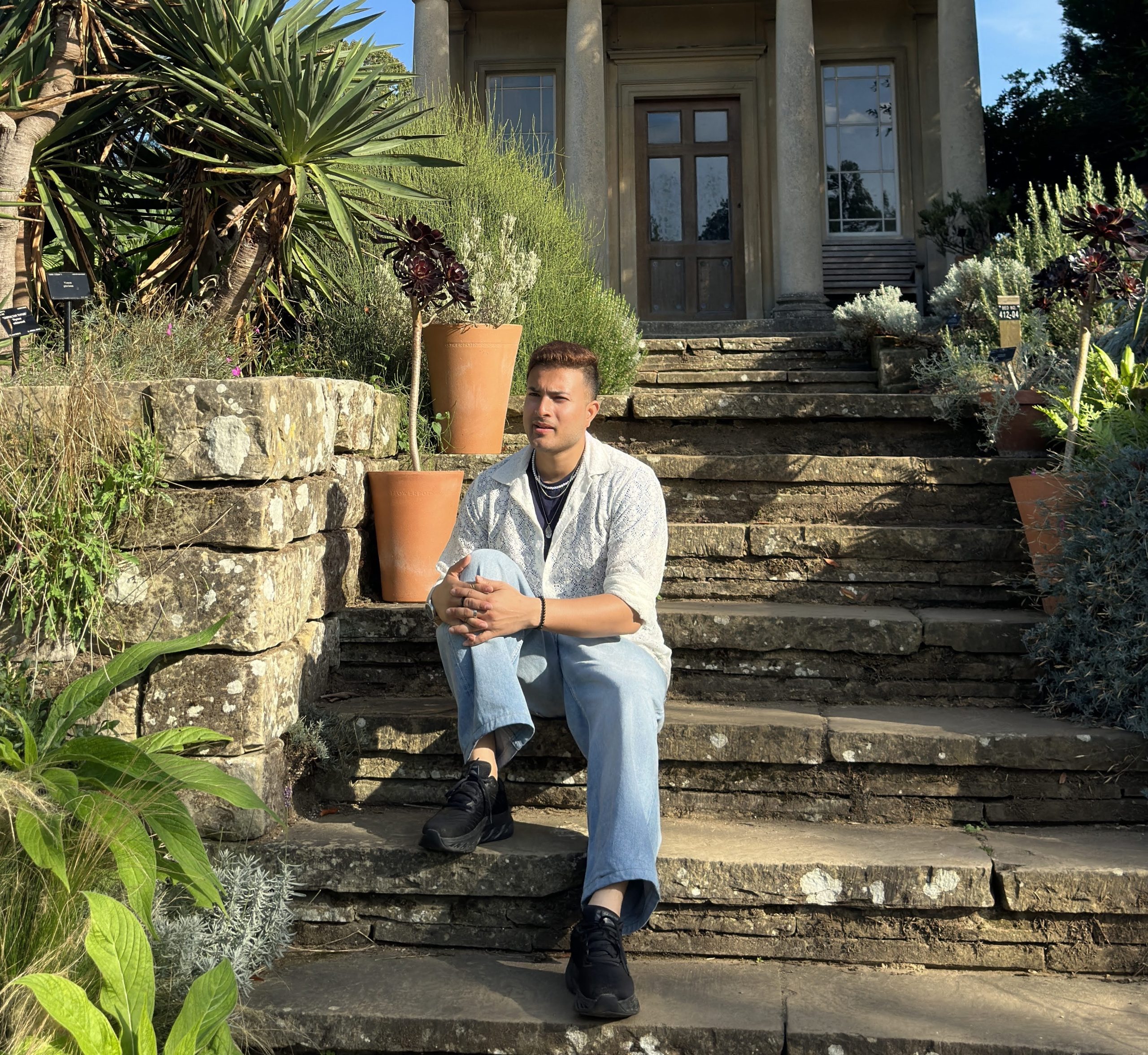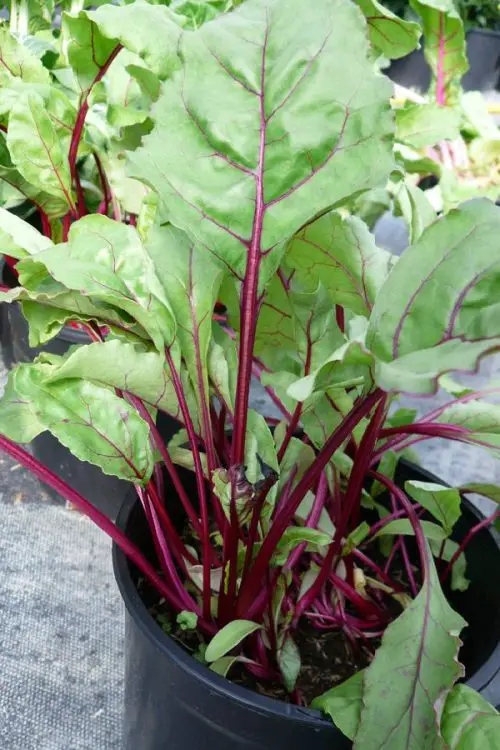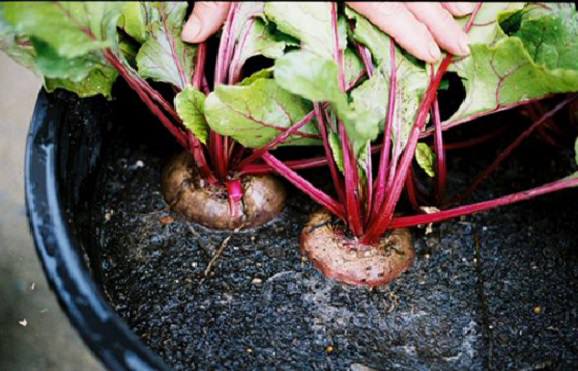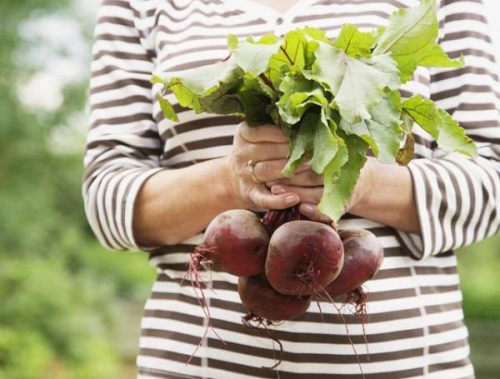Growing Beets in Containers is easy. This quick-growing vegetable doesn’t require much care and is perfect for beginner container gardeners.
Beets are one of the fast-growing vegetables, and if you’ve grown other root vegetables like radishes or carrots, then growing beets in pots is not much different.
Choosing a Pot
Use any type of container you find best with SUFFICIENT drainage holes. However, clay pots are an excellent choice.
- Growing beets is possible in small pots, but ensure they are a minimum of 8 inches deep.
- 10 to 12 inches deep pots are IDEAL as they will encourage roots to develop!
- You can choose as wide a container as you want. The wider it would be, the more beet plants you can grow together.
- Window boxes or large rectangular containers with the minimum recommended depth are great options.
Plant Pot Sizes from Inches to Gallon
Best Time to Plant Beets in Containers
As a best practice, you can start planting beets in the spring, three-two weeks before the last (average) frost date in your area. You can continue to sow seeds every 3 to 4 weeks until the temperature starts to reach above 80 F (27 C).
Again, you can begin planting in the late summer and early fall (autumn) when the temperature starts to come under the range of 85 F (29 C).
Planting Time in a Hot Climate
As beets are a cool-weather crop, those who live in warm, arid, subtropical, or tropical areas (USDA Zones 9b-12) should grow them in late fall, winter, and early spring.
How to Grow Beets in Pots
First thing first–Beets don’t like to be transplanted, so no role for seed trays! Pick desired pots and sow seeds 1/4 inch deep. Once they germinate and reach a significant height, select the healthiest seedlings and thin others apart to maintain the recommended 3 inches distance spacing.
To speed up the germination, you can also soak the seeds overnight in non-chlorinated water before planting. However, if seeds are treated with fungicide, avoid this.
When will They Appear?
The seedlings will emerge anytime between 5 to 15 days, depending on the growing conditions. Until then, keep the pots in a spot that is warm and receives mild sun.
Maintain the moisture in the soil. Once germinated, place the baby plants in the desired position, and later when seedlings grow up to 3 inches tall, thin them. To maintain the spacing recommendation mentioned below.
How to Grow Cabbage in Pots | Growing Cabbage in Containers
Best Beet Varieties for Containers
If you know how to grow beets in containers, you can try any variety. We’ve listed a few of them here: the Detroit Dark Red, Early Wonder, Sangria, and Sweetheart.
Requirements for Growing Beets in Containers
Position
Beets can be grown in full sun to part shade, but for optimum growth, pick a spot that receives full sun, or in simple words–at least 6 hours of sunlight is necessary. Also, make sure the spot you place your containers has good air circulation.
Soil
Soil that is loamy, penetrable, and promotes the development of large roots is best for growing beetroot in a pot. Make sure your soil is rich in nutrients; you can add compost and other organic matter to improve it.
Also, avoid adding gravels or stones in the bottom layer when growing this root vegetable.
If you’re not using a commercial soil mix for growing beets, prepare your own by adding 1 part garden soil, 1 part compost or well-rotted manure, and 1 part perlite.
If you want to make a soilless mix, add 1 part peat moss or coco peat, 1 part compost or well-rotted manure, and 1 part perlite, vermiculite, or sand. You can also add slow-release fertilizer that is low in nitrogen at the time of mixing the soil.
Watering
If you don’t want hard and sinewy beetroots, water regularly and evenly. To keep the soil slightly moist all the time. Ensure you do not let the soil dry out completely between the growing process, and also avoid OVERWATERING.
Spacing
Maintain the 3 inches of distance between each plant from all directions for growing beets in pots successfully.
You can grow each plant 2 inches apart if you’re growing it for tasty beet greens, but this will hamper the growth of beetroots. For your reference, a 12 inches wide rectangular pot can support around 4-5 plants.
Temperature
Keep in mind the optimum temperature for growing beets in containers require a temperature of around 50 F – 85 F (10 C – 29 C), but they can be grown in temperature as low as 40 F (4.5 C) and as high as 90 F (32 C) with some difficulty.
Growing Kale in Pots | How to Plant Kale in Containers
Beet Care in Containers
Fertilizer
It’s a good idea to use either time-based (slow-release) fertilizer or compost. As beets are root vegetables and you may like to increase their root development, use a fertilizer that is low in nitrogen but high in phosphorous and potassium—for example, a formula of NPK 5-10-10.
Once the beetroot plants growing in pots in 3-4 weeks old and doing well, switch to a water-soluble fertilizer. If you’re not adding slow-release fertilizer, you can apply liquid fertilizer as early as 2 weeks with the same 5-10-10 formula.
If you see Nitrogen deficiency in the soil, use the complete fertilizer like 20-20-20.
Suppose you want to grow beets organically, side-dress plants with compost or manure, and feed the plants with compost tea every other week. As beets usually suffer from boron deficiency, you can add seaweed (an excellent source of boron) fertilizer in compost tea for optimum growth.
Pests and Diseases
When growing beets in pots, you don’t have to worry much about pests and diseases. You can avoid most of the problems by not overwatering and avoiding overhead watering.
The common culprits are root rot and scab. Leaf miners and common pests like aphids can affect foliage growth, but you can easily control them by early measures.
Harvesting Beets
Beets, on average, require anywhere from 6-9 weeks to get ready for harvest after germination.
When to Harvest Beets
- Time Frame: Typically, beets are ready for harvest 50 to 70 days after planting, depending on the variety and growing conditions.
- Size Indicators: Beets are usually harvested when the root is between 1.5 to 3 inches in diameter. Harvesting at this stage ensures that the beets are tender.
- Leaf Indicators: Healthy and vibrant leaves can be a sign that the beet is ready to harvest.
- Testing: Gently brush away the soil from the top of a beet to check its size without disturbing the roots.
- Baby Beets: If you prefer smaller, more tender beets, they can be harvested earlier, as small as 1 inch in diameter.
Check out our article on growing Kohlrabi in pots here
How to Harvest Beets
- Watering: Water the beets lightly the day before harvesting to soften the soil.
- Loosen the Soil: Use a hand fork or spade to gently loosen the soil around the beet, being careful not to damage the roots.
- Grasp the Greens: Grasp the beet’s leaves close to the root and gently pull, twisting slightly. If resistance is felt, loosen the soil further.
- Remove Excess Soil: Shake off excess soil and trim the leaves and roots if necessary.
- Harvesting Greens: If you’re also harvesting the greens, leave an inch or two of stem attached to the root to prevent bleeding of color and nutrients.
- Multiple Harvests: If you’ve sown seeds at intervals (succession planting), you can enjoy multiple harvests over a season.
- Post-Harvest Handling: Don’t wash the beets until you’re ready to cook them, as moisture can cause them to rot in storage. Store in a cool, dark place.
Beet Greens
Beet greens, the leafy tops of the beet plant, are not only edible but also highly nutritious and versatile. Here’s a breakdown of various uses for beet greens:
1. Salads
- Raw: Young, tender beet greens can be used raw in salads, adding a fresh and slightly earthy flavor.
- Wilted: Slightly wilting the greens with a warm dressing can soften them and make for a unique salad base.
2. Cooking Greens
- Sautéed: Sauté beet greens with garlic, olive oil, and some lemon juice for a flavorful side dish.
- Stir-Fried: Add them to stir-fries, where they can be cooked with other vegetables and proteins.
3. In Soups and Stews
- Added Flavor: Beet greens can be used in soups and stews, where they add depth of flavor and extra nutrients.
- Replacement: They can replace or be used along with other leafy greens like spinach or kale.
4. Smoothies
- Nutrient Boost: Blend beet greens into smoothies for an extra nutrient boost. Their flavor pairs well with fruits like berries and bananas.
5. Sandwiches and Wraps
- Fresh Crunch: Use beet greens as a leafy addition in sandwiches and wraps for added texture and flavor.
6. Pasta Dishes
- With Pasta: Cook them down and toss them with pasta, olive oil, and Parmesan for a simple and tasty dish.
7. Juicing
- Healthy Juices: Include beet greens in your juicing routine for added vitamins and minerals.
8. As a Pizza Topping
- Unique Flavor: Use them as a gourmet pizza topping along with other fresh ingredients.
9. Steamed
- Simple Side: Steamed beet greens, seasoned with salt and pepper, make a light and nutritious side dish.
Find out some Healthy Smoothie and Juice Plants for the Garden here
Growing Beets in Containers – FAQs
1. What Size Container Should I Use for Growing Beets?
- Answer: A container that is at least 12 inches wide and 10 inches deep is typically suitable for growing beets. The size might vary depending on the number of plants and the beet variety.
2. What Type of Soil is Best for Beets in Containers?
- Answer: Use a well-draining potting mix that is rich in organic matter. A mix of compost, peat moss, and vermiculite can be ideal.
3. How Many Beet Seeds Can I Plant in a Container?
- Answer: Space the seeds about 2-3 inches apart. If you’re planting seedlings, thin them to the same distance once they’ve sprouted to give them room to grow.
4. How Often Should I Water Container Beets?
- Answer: Keep the soil evenly moist but not soggy. Containers tend to dry out faster, so check the soil regularly, especially in hot weather.
5. Can Beets Grow Indoors in Containers?
- Answer: Yes, beets can grow indoors if provided with sufficient light, such as a south-facing window or supplemental grow lights.
Best Ferns for Containers that Grow Indoors & Outdoors Easily
6. What are Common Pests and Diseases, and How Can I Prevent Them?
- Answer: Aphids and leaf miners can be common pests. Regular inspection, proper watering, and the use of insecticidal soap can help control them. Crop rotation and proper spacing can prevent fungal diseases.
7. How Long Does It Take for Beets to Grow in Containers?
- Answer: Depending on the variety, beets usually take between 50 to 70 days from planting to harvest.
8. Can I Also Harvest the Greens of the Beets in Containers?
- Answer: Absolutely! Beet greens can be harvested without harming the root, and they are highly nutritious.
9. What’s the Best Fertilizer for Container Beets?
- Answer: A balanced, slow-release vegetable fertilizer with equal parts nitrogen, phosphorus, and potassium is typically suitable.
10. Can I Grow Beets Year-Round in Containers?
- Answer: In mild climates, beets can often be grown year-round. In colder climates, they can be grown indoors with adequate light.







Not sure if this is where i ask a question. Took out a old claw foot tub, want to plant in it. How can I prepare for this. Worried about water drainage.
fill the tub with a good layer of plastic bottles (fills up space and allows for drainage where you don’t need to drill extra holes in that cast iron tub); place layer of coconut fiber to cover. Then add a good layer of garden soil so plants can get a good root growth. Good luck!
Your useful ideas encouraged me to grow various flowering plants, and vegetables at home. I m very happy bcoz it’s fetching good results. Thank you so much. Sunanda
Your useful ideas encouraged me to grow various flowering plants and vegetables at home. I am happy because it’s fetching good results. Thank you.
It’s my first time growing beets in a pot. I love beets & hope the heat of late July aug won’t make them Bolt?
Leaf miners? is there a natural way to deal with them? I know aphids watering every day will break their reproduction cycle, but you mentioned not overhead watering. Thanks for all your wonderful info. My mom was a master beet grower and family enjoyed beet pickles immensely.